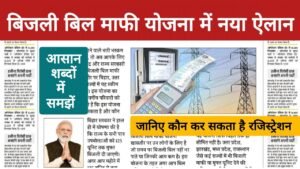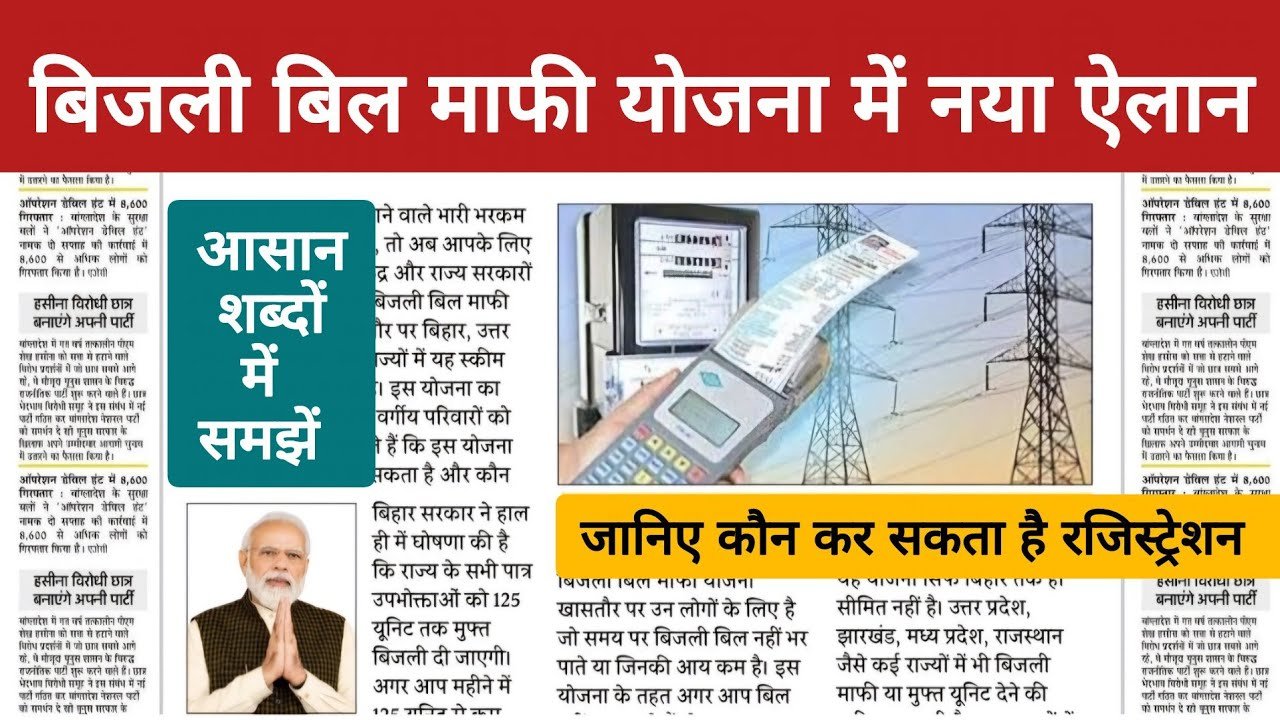Electricity Bill Waiver Scheme 2025: Complete Guide on Free & Waived Pending Power Bills for Poor and Middle-Class Families
Electricity is no longer a luxury; it is a basic necessity for every household in India. However, millions of families—especially from poor and middle-class backgrounds—struggle each month to clear their electricity bills. In response to this, the government has launched the Electricity Bill Waiver Scheme 2025, under which pending electricity dues of eligible households will be waived off completely.

This article provides you with a detailed, step-by-step guide about the scheme, its benefits, eligibility, documents required, how to apply, and most importantly, how this initiative will impact the lives of common citizens.
📌 Table of Contents
Introduction to Electricity Bill Waiver Scheme 2025
Why the Government Launched This Scheme?
Key Highlights of the Scheme
Who Will Benefit? (Eligibility Criteria)
Categories of Beneficiaries
Documents Required for Application
How to Apply Online? Step-by-Step Process
Offline Application Process
State-Wise Implementation of the Scheme
Benefits for Poor Families
Benefits for Middle-Class Families
Special Provisions for Farmers & Small Businesses
Impact on Women & Rural Households
Impact on Urban Consumers
Financial Implications for State Governments
Challenges in Implementation
How the Government Will Recover Losses?
Future of Electricity Subsidies in India
Common FAQs about Electricity Bill Waiver Scheme
Final Thoughts
Disclaimer
1. Introduction to Electricity Bill Waiver Scheme 2025
The Electricity Bill Waiver Scheme 2025 is a social welfare initiative by the government to reduce the financial burden of electricity bills on poor and middle-class families. The scheme proposes to waive off pending dues (old electricity bills) for lakhs of consumers who are unable to clear their bills due to financial hardships.
This will ensure that electricity connections are not disconnected, and families can continue to have access to power for their basic needs like education, healthcare, and livelihood.
2. Why the Government Launched This Scheme?
The decision to waive off electricity dues was influenced by multiple factors:
Rising unemployment and reduced income levels.
Increasing electricity tariffs year by year.
Growing complaints from middle-class families about pending dues.
The government’s vision of uninterrupted electricity supply for all households under “Power for All”.
The need to revive discoms (distribution companies) by restructuring pending dues.
3. Key Highlights of Electricity Bill Waiver Scheme 2025
| Feature | Details |
|---|---|
| Scheme Name | Electricity Bill Waiver Scheme 2025 |
| Launched by | Central & State Governments (jointly) |
| Beneficiaries | Poor families, middle-class households, farmers, small shopkeepers |
| Main Benefit | Waiver of pending/old electricity bills |
| Applicable States | Nationwide, but implementation varies by state |
| Mode of Application | Online & Offline |
| Official Portal | State-wise electricity board websites |
4. Who Will Benefit? (Eligibility Criteria)
To ensure transparency and fair distribution, the scheme has specific eligibility conditions:
Household income must be below ₹3 lakh per year for poor category.
Middle-class families with annual income up to ₹6 lakh per year may also be eligible.
Must have a domestic electricity connection (not commercial/industrial).
Pending bills should be registered under the consumer ID.
Priority given to single women households, farmers, and BPL families.
5. Categories of Beneficiaries
| Category | Income Slab | Benefits under Scheme |
|---|---|---|
| Poor Families (BPL) | Less than ₹3,00,000/year | 100% waiver on pending dues |
| Lower Middle Class | ₹3,00,000 – ₹6,00,000/year | Up to 50% waiver on dues |
| Farmers | Based on agricultural connection | 100% waiver or subsidy |
| Small Shopkeepers | Turnover under ₹20 lakh/year | Partial relief in bills |
6. Documents Required for Application
Applicants need to submit the following documents:
Aadhaar Card
Ration Card (BPL/APL)
Income Certificate
Latest Electricity Bill Copy
Consumer Number / Connection ID
Passport size photo
Bank Passbook (for verification)
Mobile Number & Email ID
7. How to Apply Online? Step-by-Step Process
Visit the official State Electricity Board website.
Click on Electricity Bill Waiver Scheme 2025 link.
Register with Aadhaar & Mobile Number.
Enter Consumer ID from your electricity bill.
Upload necessary documents in PDF/JPEG format.
Submit application and take acknowledgment slip.
Status can be checked online using application ID.
8. Offline Application Process
Visit your nearest Electricity Board Office or Gram Panchayat Office.
Collect the application form.
Fill in required details (Consumer Number, Aadhaar, Income details).
Attach photocopies of documents.
Submit at counter and collect acknowledgment receipt.
9. State-Wise Implementation of the Scheme
Different states are implementing the scheme differently.
| State | Status | Relief Offered |
|---|---|---|
| Uttar Pradesh | Announced | 100% waiver for BPL families |
| Bihar | Announced | Waiver up to ₹1 lakh pending dues |
| Madhya Pradesh | Active | Free 150 units + pending dues waiver |
| Rajasthan | Active | Poor families get 100% waiver |
| Maharashtra | Under Discussion | Expected subsidy-based waiver |
10. Benefits for Poor Families
100% pending dues waiver.
Restoration of disconnected power supply.
Reduced financial stress.
Access to uninterrupted electricity for cooking, studying, and livelihood.
11. Benefits for Middle-Class Families
Partial waiver (25–50%).
Relief from rising tariffs.
Reduced financial burden, especially for salaried families.
Encouragement to pay future bills on time.
12. Special Provisions for Farmers & Small Businesses
Farmers with agricultural connections will get full waiver.
Small shops and vendors will get subsidized rates.
Ensures uninterrupted power for irrigation and local economy growth.
13. Impact on Women & Rural Households
Women in rural areas will benefit from reduced financial stress.
Access to electricity helps in education of children.
Promotes digital inclusion (TV, Internet, online learning).
14. Impact on Urban Consumers
Middle-class salaried professionals get relief.
Reduces pending litigation of unpaid dues.
Improves trust between consumers & electricity boards.
15. Financial Implications for State Governments
The scheme will cost thousands of crores, but governments plan to:
Allocate funds from welfare budgets.
Use central government subsidies.
Encourage timely bill payment in future.
Restructure loans of state electricity boards.
16. Challenges in Implementation
Ensuring only genuine beneficiaries get waiver.
Financial stress on electricity boards.
Preventing misuse by higher-income families.
Need for transparent verification process.
17. How the Government Will Recover Losses?
By restructuring pending electricity board loans.
By encouraging solar energy adoption.
By introducing smart meters to reduce theft.
Through better subsidy management.
18. Future of Electricity Subsidies in India
The waiver is a short-term relief, but in the long term, government plans to:
Provide direct subsidies in bank accounts.
Promote solar panels in rural homes.
Introduce prepaid smart meters.
Ensure 24×7 affordable electricity to all.
19. Common FAQs about Electricity Bill Waiver Scheme
Q1: Who is eligible for full bill waiver?
A1: Poor families (BPL) and farmers.
Q2: Do middle-class families get benefits?
A2: Yes, they get partial waiver.
Q3: How can I apply?
A3: Online through your state electricity board website or offline via nearest office.
Q4: Is it available in all states?
A4: Yes, but implementation differs from state to state.
Q5: Will future bills also be free?
A5: No, only pending dues are waived. Future bills must be paid regularly.
20. Final Thoughts
The Electricity Bill Waiver Scheme 2025 is a historic decision that will provide relief to millions of families across India. It is not just about waiving dues—it is about ensuring energy security, dignity, and stability for poor and middle-class households.
If implemented effectively, this scheme can bridge the gap between affordable energy and sustainable growth.
21. Disclaimer
This article is for informational purposes only. The Electricity Bill Waiver Scheme 2025 is subject to official notifications from respective state governments and electricity boards. Eligibility, benefits, and application processes may vary by state. Readers are advised to check the official electricity board website or contact the local office for the most accurate and updated information.
